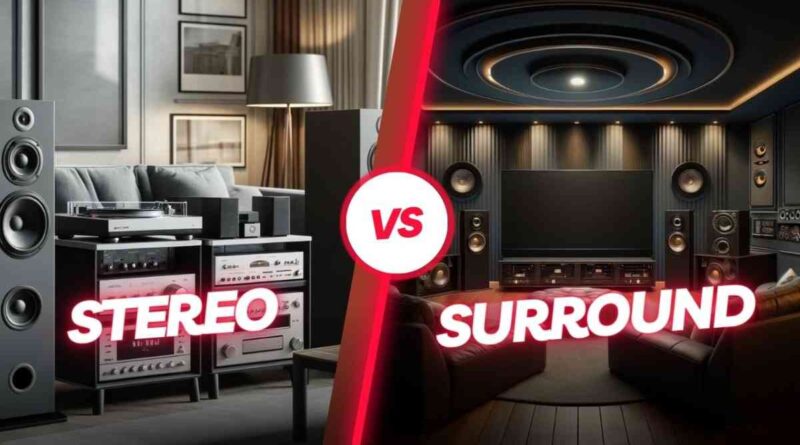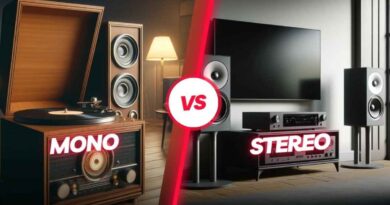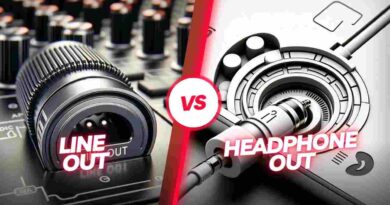Stereo vs Surround: What’s The Key Difference?
Ever wondered why some movies sound like you’re right in the middle of the action, while others feel more like a flat performance? The answer lies in the magic of sound systems! Two main types dominate the home audio experience: stereo and surround sound. But which one is right for you?
This guide will break down the key differences between stereo and surround sound, helping you choose the perfect setup for your needs. We’ll cover:
- The number of speakers: Stereo uses just two speakers, while surround sound employs multiple speakers strategically placed around the room.
- The listening experience: Stereo creates a wide, front-facing soundstage, while surround sound engulfs you in a 360-degree auditory experience.
- Content compatibility: Most music is mastered in stereo, while movies and games are increasingly designed for surround sound.
- Space and budget considerations: Stereo systems are simpler and more affordable, while surround sound requires more speakers and potentially a receiver.
So by understanding these key points, you’ll be well on your way to selecting the ideal audio setup to elevate your entertainment experience!
What is Stereo Sound?
Stereo, short for stereophonic sound, refers to a method of sound reproduction that creates an illusion of multi-directional audible perspective. This is typically achieved by using two audio channels (left and right) through two speakers.
Characteristics of Stereo Sound
Stereo sound systems are widely used because of their simplicity and effectiveness in a range of listening environments. The setup involves two speakers positioned on either side of the listener, creating a sound image that simulates natural hearing. The primary characteristics include:
- Directionality: Stereo provides a directional sound experience, allowing you to perceive the location of instruments or vocal sources within a left-right spectrum.
- Space Requirements: Stereo setups require minimal space, making them ideal for personal listening environments like home offices or bedrooms.
- Music Listening: Stereo is particularly favored for listening to music because it closely replicates the soundstage as it was intended during mixing and mastering.
Key Takeaways
- Stereo setups are ideal for personal and intimate listening spaces.
- They excel in music reproduction, providing a clear and direct audio path.
What is Surround Sound?
Surround sound systems are designed to envelop the listener in audio, creating a 360-degree sound environment. This is accomplished through the use of multiple speakers placed around the listener, often including front, side, rear, and sometimes overhead channels.
Characteristics of Surround Sound
Surround sound systems are complex and provide a more immersive audio experience compared to stereo systems. They are typically used in home theaters and gaming setups. The characteristics include:
- Immersiveness: With speakers surrounding the listener, the audio environment is more immersive, making it ideal for movies and games.
- Component Complexity: A surround sound system involves multiple speakers, which may include a subwoofer for bass and additional speakers for mid to high frequencies.
- Setup and Calibration: Setting up a surround sound system requires careful placement of speakers and calibration to achieve the optimal sound field.
Key Takeaways
- Surround sound systems are best for immersive experiences in movies and gaming.
- They require more space and setup effort compared to stereo systems.
Stereo vs Surround: Key Differences
Differences in Sound Quality
When comparing stereo and surround sound systems, the quality of audio reproduction is a major consideration. Here’s how they differ in terms of sound quality:
Clarity and Detail
Stereo systems often provide clearer sound with more defined details, as the audio is less diffused across multiple channels. This clarity is particularly noticeable in acoustic music or vocal tracks where nuance is crucial.
Immersive Experience
Surround sound systems excel in creating an immersive listening experience. The use of multiple channels allows for a more dynamic representation of sound, making it feel like you’re in the middle of the action—be it a movie scene or a video game environment.
Key Takeaways
- Stereo excels in clarity and detail, making it ideal for music enthusiasts.
- Surround sound offers a more engaging experience for movies and games.
Comparison of Technical Specifications
When deciding between stereo and surround sound systems, technical specifications play a crucial role. Let’s look at some of the technical aspects of both setups:
Power Output
Stereo systems generally require less power compared to surround systems due to the fewer number of speakers. However, the power needed can vary significantly depending on the quality and type of speakers used.
Frequency Response
Both systems aim to cover a full range of audible frequencies from 20 Hz to 20 kHz. However, surround sound systems often include a subwoofer specifically designed to handle lower frequencies, enhancing the overall depth of sound.
Key Takeaways
- Stereo systems are more power-efficient but may lack the lower frequency effects without additional subwoofers.
- Surround sound systems typically offer a broader dynamic range, especially in the bass region.
Set-Up Requirements
Setting up audio systems requires consideration of space, speaker placement, and acoustics. Here are the setup requirements for both stereo and surround sound systems:
Stereo System Setup
Setting up a stereo system is relatively straightforward. The key is to position the two speakers at ear level and at an angle that forms an equilateral triangle with the listening position. This setup ensures optimal sound distribution and stereo imaging.
Surround Sound System Setup
Surround sound setup is more involved. It requires positioning multiple speakers around the room to create an enveloping sound field. Calibration with an audio processor is often necessary to balance the sound from all speakers, depending on the room’s acoustics.
Key Takeaways
- Stereo systems are easier and quicker to set up.
- Surround systems require more precise placement and calibration for optimal performance.
Ideal Usage Scenarios
Choosing between stereo and surround sound depends largely on your primary use case. Here are some scenarios where each system might be preferable:
Best for Music: Stereo
For pure music listening, stereo is often the better choice. It provides ample spatial imaging that accurately reflects the musical stage intended by the recording engineer.
Best for Movies and Games: Surround Sound
For an immersive cinematic or gaming experience, surround sound is superior. It enhances the realism of soundtracks and sound effects, making you feel part of the scene.
Key Takeaways
- Stereo is preferred for music due to its accurate soundstage reproduction.
- Surround sound is ideal for enhancing the audio experience in movies and games.
Conclusion: Which is Best?
Determining which audio system is best depends on your personal needs and the primary use of the system. If you are an avid music listener who values audio fidelity, a stereo system is likely your best choice. For those who enjoy movies and gaming and want to be immersed in the sound, a surround sound system will greatly enhance your experience.
In my opinion, the choice between stereo and surround depends on what you value more in your listening experience—clarity and precision for music, or immersion and breadth for movies and games. Both systems have their merits and can significantly enhance your audio experience based on your preferences.
Frequently Asked Questions
Which is better for a small apartment, stereo or surround?
Stereo systems are generally better for small spaces due to their simpler setup and space requirements.
Can I use a stereo system for watching movies?
Yes, a stereo system can be used for movies, though it won’t be as immersive as a surround sound system.
Is surround sound worth the extra cost and setup?
If you value a cinematic experience at home, surround sound is definitely worth the investment.
Can stereo speakers be part of a surround sound system?
Yes, stereo speakers can be integrated into a surround system as the front left and right channels.
Do I need a receiver for a stereo system?
A receiver can enhance the sound quality and provide additional inputs, but it’s not always necessary.
How much should I expect to spend on a good stereo system?
Good stereo systems can range from a few hundred to several thousand dollars, depending on quality.
What are the main components of a surround sound system?
A typical surround sound system includes front, rear, and center channel speakers, and often a subwoofer.
How do I know if a surround system is right for my home?
Consider your room size, budget, and primary use (movies/games) to determine if surround sound is suitable.
What maintenance does a surround sound system require?
Regular cleaning and occasional recalibration are recommended to maintain performance.
Can I upgrade my stereo system to surround sound?
Yes, you can upgrade by adding additional speakers and a receiver capable of decoding surround sound formats.




